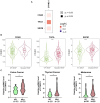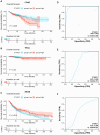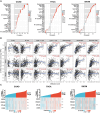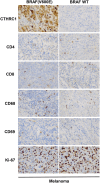CTHRC1 is associated with BRAF(V600E) mutation and correlates with prognosis, immune cell infiltration, and drug resistance in colon cancer, thyroid cancer, and melanoma
- PMID: 39052013
- PMCID: PMC11647256
- DOI: 10.17305/bb.2024.10397
CTHRC1 is associated with BRAF(V600E) mutation and correlates with prognosis, immune cell infiltration, and drug resistance in colon cancer, thyroid cancer, and melanoma
Abstract
Colon cancer, thyroid cancer, and melanoma are common malignant tumors that seriously threaten human health globally. The B-Raf proto-oncogene, serine/threonine kinase (BRAF)(V600E) mutation is an important driver gene mutation in these cancer types. In this study, we identified that collagen triple helix repeat containing 1 (CTHRC1) expression was associated with the BRAF(V600E) mutation in colon cancer, thyroid cancer, and melanoma. Based on database analysis and clinical tissue studies, CTHRC1 was verified to correlate with poor prognosis and worse clinicopathological features in colon cancer and thyroid cancer patients, but not in patients with melanoma. Several signaling pathways, immune cell infiltration, and immunotherapy markers were associated with CTHRC1 expression. Additionally, a high level of CTHRC1 was correlated with decreased sensitivity to antitumor drugs (vemurafenib, PLX-4720, dabrafenib, and SB-590885) targeting the BRAF(V600E) mutation. This study provides evidence of a significant correlation between CTHRC1 and the BRAF(V600E) mutation, suggesting its potential utility as a diagnostic and prognostic biomarker in human colon cancer, thyroid cancer, and melanoma.
Conflict of interest statement
Conflicts of interest: Authors declare no conflicts of interest.
Figures








Similar articles
-
Unusually long-term responses to vemurafenib in BRAF V600E mutated colon and thyroid cancers followed by the development of rare RAS activating mutations.Cancer Biol Ther. 2018;19(10):871-874. doi: 10.1080/15384047.2018.1480289. Epub 2018 Jul 23. Cancer Biol Ther. 2018. PMID: 30036146 Free PMC article.
-
Long-term vemurafenib treatment drives inhibitor resistance through a spontaneous KRAS G12D mutation in a BRAF V600E papillary thyroid carcinoma model.Oncotarget. 2016 May 24;7(21):30907-23. doi: 10.18632/oncotarget.9023. Oncotarget. 2016. PMID: 27127178 Free PMC article.
-
Dabrafenib therapy for advanced melanoma.Ann Pharmacother. 2014 Apr;48(4):519-29. doi: 10.1177/1060028013513009. Epub 2013 Nov 20. Ann Pharmacother. 2014. PMID: 24259661 Review.
-
B-Raf Inhibition in the Clinic: Present and Future.Annu Rev Med. 2016;67:29-43. doi: 10.1146/annurev-med-090514-030732. Annu Rev Med. 2016. PMID: 26768236
-
Dabrafenib and its potential for the treatment of metastatic melanoma.Drug Des Devel Ther. 2012;6:391-405. doi: 10.2147/DDDT.S38998. Epub 2012 Dec 11. Drug Des Devel Ther. 2012. PMID: 23251089 Free PMC article. Review.
Cited by
-
A Narrative Review of the Role of Immunotherapy in Metastatic Carcinoma of the Colon Harboring a BRAF Mutation.In Vivo. 2025 Jan-Feb;39(1):25-36. doi: 10.21873/invivo.13802. In Vivo. 2025. PMID: 39740863 Free PMC article. Review.
References
-
- Li G, Feng H, Chen Q, Xue C, Li M, Liu X, et al. Identification of immune infiltration-related LncRNA FAM83C-AS1 for predicting prognosis and immunotherapy response in colon cancer. Transpl Immunol. 2021;69:101481. https://doi.org/10.1016/j.trim.2021.101481. - PubMed
-
- Chavda J, Bhatt H. Systemic review on B-Raf(V600E) mutation as potential therapeutic target for the treatment of cancer. Eur J Med Chem. 2020;206:112675. https://doi.org/10.1016/j.ejmech.2020.112675. - PubMed
-
- Guenter R, Patel Z, Chen H. Notch signaling in thyroid cancer. Adv Exp Med Biol. 2021;1287:155–68. https://doi.org/10.1007/978-3-030-55031-8/_10. - PMC - PubMed
-
- Abdullah MI, Junit SM, Ng KL, Jayapalan JJ, Karikalan B, Hashim OH. Papillary Thyroid cancer: genetic alterations and molecular biomarker investigations. Int J Med Sci. 2019;16(3):450–60. https://doi.org/10.7150/ijms.29935. - PMC - PubMed
-
- Ahmed B, Qadir MI, Ghafoor S. Malignant melanoma: skin cancer-diagnosis, prevention, and treatment. Crit Rev Eukaryot Gene Expr. 2020;30(4):291–7. https://doi.org/10.1615/CritRevEukaryotGeneExpr.2020028454. - PubMed
MeSH terms
Substances
LinkOut - more resources
Full Text Sources
Medical
Research Materials
Miscellaneous

